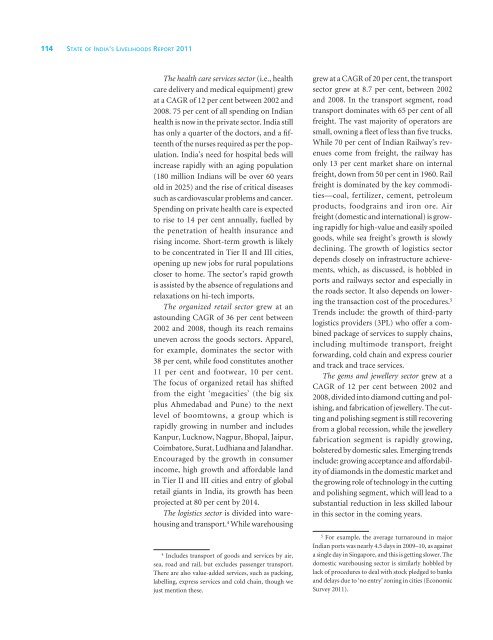SOIL Report 2011 - ACCESS Development Services
SOIL Report 2011 - ACCESS Development Services
SOIL Report 2011 - ACCESS Development Services
- No tags were found...
Create successful ePaper yourself
Turn your PDF publications into a flip-book with our unique Google optimized e-Paper software.
114 State of India’s Livelihoods <strong>Report</strong> <strong>2011</strong>The health care services sector (i.e., healthcare delivery and medical equipment) grewat a CAGR of 12 per cent between 2002 and2008. 75 per cent of all spending on Indianhealth is now in the private sector. India stillhas only a quarter of the doctors, and a fifteenthof the nurses required as per the population.India’s need for hospital beds willincrease rapidly with an aging population(180 million Indians will be over 60 yearsold in 2025) and the rise of critical diseasessuch as cardiovascular problems and cancer.Spending on private health care is expectedto rise to 14 per cent annually, fuelled bythe penetration of health insurance andrising income. Short-term growth is likelyto be concentrated in Tier II and III cities,opening up new jobs for rural populationscloser to home. The sector’s rapid growthis assisted by the absence of regulations andrelaxations on hi-tech imports.The organized retail sector grew at anastounding CAGR of 36 per cent between2002 and 2008, though its reach remainsuneven across the goods sectors. Apparel,for example, dominates the sector with38 per cent, while food constitutes another11 per cent and footwear, 10 per cent.The focus of organized retail has shiftedfrom the eight ‘megacities’ (the big sixplus Ahmedabad and Pune) to the nextlevel of boomtowns, a group which israpidly growing in number and includesKanpur, Lucknow, Nagpur, Bhopal, Jaipur,Coimbatore, Surat, Ludhiana and Jalandhar.Encouraged by the growth in consumerincome, high growth and affordable landin Tier II and III cities and entry of globalretail giants in India, its growth has beenprojected at 80 per cent by 2014.The logistics sector is divided into warehousingand transport. 4 While warehousing4Includes transport of goods and services by air,sea, road and rail, but excludes passenger transport.There are also value-added services, such as packing,labelling, express services and cold chain, though wejust mention these.grew at a CAGR of 20 per cent, the transportsector grew at 8.7 per cent, between 2002and 2008. In the transport segment, roadtransport dominates with 65 per cent of allfreight. The vast majority of operators aresmall, owning a fleet of less than five trucks.While 70 per cent of Indian Railway’s revenuescome from freight, the railway hasonly 13 per cent market share on internalfreight, down from 50 per cent in 1960. Railfreight is dominated by the key commodities—coal,fertilizer, cement, petroleumproducts, foodgrains and iron ore. Airfreight (domestic and international) is growingrapidly for high-value and easily spoiledgoods, while sea freight’s growth is slowlydeclining. The growth of logistics sectordepends closely on infrastructure achievements,which, as discussed, is hobbled inports and railways sector and especially inthe roads sector. It also depends on loweringthe transaction cost of the procedures. 5Trends include: the growth of third-partylogistics providers (3PL) who offer a combinedpackage of services to supply chains,including multimode transport, freightforwarding, cold chain and express courierand track and trace services.The gems and jewellery sector grew at aCAGR of 12 per cent between 2002 and2008, divided into diamond cutting and polishing,and fabrication of jewellery. The cuttingand polishing segment is still recoveringfrom a global recession, while the jewelleryfabrication segment is rapidly growing,bolstered by domestic sales. Emerging trendsinclude: growing acceptance and affordabilityof diamonds in the domestic market andthe growing role of technology in the cuttingand polishing segment, which will lead to asubstantial reduction in less skilled labourin this sector in the coming years.5For example, the average turnaround in majorIndian ports was nearly 4.5 days in 2009–10, as againsta single day in Singapore, and this is getting slower. Thedomestic warehousing sector is similarly hobbled bylack of procedures to deal with stock pledged to banksand delays due to ‘no entry’ zoning in cities (EconomicSurvey <strong>2011</strong>).














